Topic: Plate Tectonics
Plate Tectonics
A ship is at a location of 40° S 77° W. Which type of surface ocean current and tectonic plate boundary are located beneath this ship?
(1) warm ocean current and a transform boundary
(2) warm ocean current and a convergent boundary
(3) cool ocean current and a transform boundary
(4) cool ocean current and a convergent boundary
Which table correctly matches the average density and composition of continental and oceanic crusts?
(1) 
(2) 
(3) 
(4) 
The photograph below shows a portion of the San Andreas Fault in the western United States.
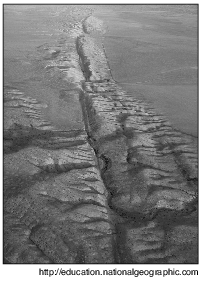
The San Andreas Fault is an example of a
(1) transform plate boundary
(2) divergent plate boundary
(3) convergent plate boundary
(4) complex plate boundary
Which world map shows the locations where most earthquakes and volcanoes occur on Earth?
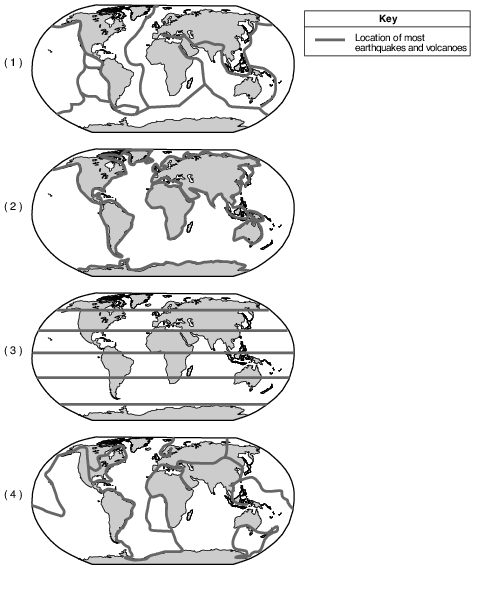
(1) 1
(2) 2
(3) 3
(4) 4
The arrival time of the first earthquake P-wave at a seismograph station was 10:11:20 (hours:minutes:seconds). If the epicenter of the earthquake is 8000 km away, what was the approximate arrival time of the first S-wave from this earthquake?
(1) 10:02:00
(2) 10:09:20
(3) 10:20:40
(4) 10:32:00
The diagram below represents the intensity of the shaking that occurs on different Earth surfaces during the same earthquake.

The greatest earthquake hazard to homes exists when they are built on
(1) hard igneous rock
(2) sedimentary rock
(3) coarse sediments
(4) silt and mud
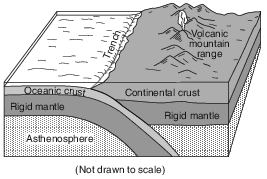
Which tectonic plate boundary is best represented by this diagram?
(1) Nazca Plate and Pacific Plate boundary
(2) Scotia Plate and South American Plate boundary
(3) Juan de Fuca Plate and North American Plate boundary
(4) Antarctic Plate and Indian-Australian Plate boundary
Crustal Activity at Mid-Ocean Ridges
Mid-ocean ridges are found at one type of tectonic plate boundary. These ridges consist of extensive underwater mountain ranges split by rift valleys. The rift valleys mark places where two crustal plates are pulling apart, widening the ocean basins, and allowing magma from the asthenosphere to move upward. In some cases, mid-ocean ridges have migrated toward nearby mantle hot spots. This explains why mid-ocean ridges and mantle hot spots are found together at several locations.
Which type of tectonic plate boundary is located at mid-ocean ridges?
(1) convergent
(2) transform
(3) divergent
(4) complex
Mt. Redoubt Volcano
In Anchorage, Alaska, scientists are monitoring sensors located on nearby Mt. Redoubt. The sensors measure seismic activity at the top of the volcano. No one lives near the volcano itself, so there is no danger to humans from lava flows, but ash can be dangerous when breathed in, and can damage airplanes and automobiles if the ash is drawn into their engines. When Mt. Redoubt erupted in 1989, a huge ash cloud reached an approximate height of 7.6 miles above sea level, and spread ash across Alaska for five months. The ash was composed largely of silica, which cooled rapidly as the ash rose into the atmosphere. In March 2009, Mt. Redoubt erupted again.

Mt. Redoubt’s seismic activity is due to the interaction of which two tectonic plates?
(1) Pacific Plate and Eurasian Plate
(2) Eurasian Plate and North American Plate
(3) North American Plate and Pacific Plate
(4) Philippine Plate and Eurasian Plate



Identify the landmass that collided with the eastern coast of North America to create the Acadian mountain range and the basin for the deposition of the Devonian rock units in table A. [1]
Allow 1 credit for Avalon.
On the cross section in the image provided, draw two arrows, one on each side of fault X, to show the relative direction of movement of the rock units that occurred during faulting. [1]
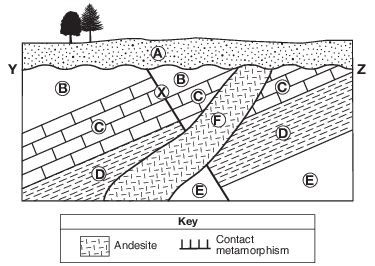
Allow 1 credit if two arrows are correctly drawn approximately parallel to the fault, showing the relative motion, as shown.
• Note: Allow credit even if the arrows extend through rock F.
• Do not allow credit for any arrow in layer A, only.
The Niagara Escarpment
A prominent feature found along the shore of Lake Ontario in western New York State is the Niagara Escarpment. This escarpment is the remains of an ancient seabed that was formed when the area was covered by a warm, shallow sea from approximately450 to 430 million years ago. Erosion of the Taconic Mountains to the east provided
the sediments deposited in this basin area. From these sediments, rock layers such as shale, sandstone, and limestone formed. Later, magnesium replaced some of the calcium in the top layer of limestone, turning it into a dolostone layer. When the high ocean levels of the Ordovician Period dropped, the draining of this inland sea caused unequal erosion of the exposed layers. The South Moraine was deposited on the top of the Niagara Escarpment in this region.

Describe the tectonic event that caused the Taconian orogeny. [1]
Allow 1 credit. Acceptable responses include, but are not limited to:
• — the collision between North America and a volcanic island arc
• — closing of the western part of the Iapetus Ocean
• — crustal uplift
• — convergence
On the cross section in the image provided, draw two arrows, one on each side of line XY, to show the direction of relative movement that has occurred along the fault. [1]
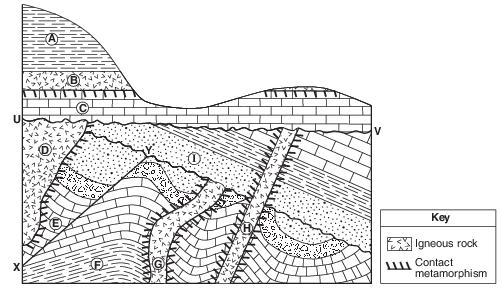
Allow 1 credit for one arrow pointing downward on the left side of line XY and one arrow pointing upward on the right side of line XY.
• Example of a 1-credit response:
• 
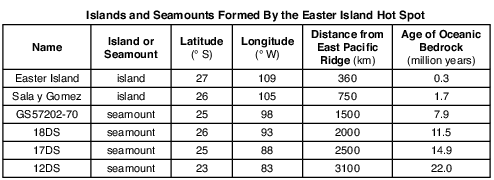
Identify the name of tectonic plate A. [1]
Plate
Allow 1 credit for Pacific Plate.
The Great Rift Valley
Rifting of Earth’s crust in eastern Africa began during the Neogene Period as the Ethiopian and Kenyan Domes formed. These two huge domes were created as Earth’s mantle pushed up the overlying crust. As the crust was forced upward, the resulting tension cracked the crust, resulting in the eruption of volcanoes and the formation of large rifts. The crust continued to pull apart, forming rift valleys. These valleys have become deeper and are currently becoming filled with sediments, igneous rock, and water.

Which two lithospheric plates are separated by a mid-ocean ridge in the northeastern portion of the Ethiopian Dome? [1]
Plate and _____________________________ Plate
Allow 1 credit for Arabian Plate and African Plate.
